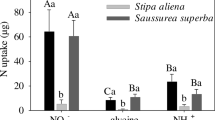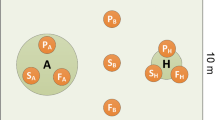Abstract
Niche partitioning by time, space and chemical forms has been suggested as an important mechanism to maintain species coexistence. Climate warming is assumed to increase soil nutrient availability through enhancing mineralization of soil organic matter in a variety of terrestrial ecosystems. However, few studies have yet examined how dominant plant species contribute to species coexistence when nutrient enrichment occurs in native ecosystems. We studied a single fairy ring (5 m diameter) in a Kobresia meadow in the Tibetan Plateau. This kind of rings is caused by a basidiomycete fungus Agaricus campestris, and is evidenced by dark-green vegetation boundaries. Nutrient enrichment occurs due to enhanced decomposition of soil organic matter (SOM) in the fungus growth zone of these rings. We conducted a short-term 15N labelling experiment and found that dominant plant species shifted their N uptake patterns and preferred N form (NO −3 , NH +4 , and amino acid N) in response to nutrient enrichment in an N-limited alpine meadow. The legume Gueldenstaedtia diversifolia had the lowest aboveground biomass among the five plant species studied at low available N level, although it mainly utilized ammonium (the most abundant N form). The two graminoids (Elymus nutans and Stipa aliena) demonstrated similar aboveground biomass at low and high available N levels, showing a similar pattern switching from NH +4 /NO −3 uptake outside the ring to glycine uptake in the annulus zone of the ring. The biomass of the forb Gentiana straminea differed significantly at low and high available N levels, but its N uptake pattern almost remained unchanged. Species therefore differed in their response to nutrient enrichment, most species showing chemical niche shifts instead of niche conservatism. This finding has important implications with regard to understanding the mechanisms responsible for species coexistence when natural nutrient enrichment is induced by climate warming in terrestrial ecosystems.




Similar content being viewed by others
References
Allison SD, Hanson CA, Treseder KK (2007) Nitrogen fertilization reduces diversity and alters community structure of active fungi in boreal ecosystems. Soil Biol Biochem 39:1878–1887
Bais HP, Vepachedu R, Gilroy S, Callaway RM, Vivanco JM (2003) Allelopathy and exotic plant invasion: from molecules and genes to species interactions. Science 301:1377–1380
Berendse F, Elberse WT (1990) Competition and nutrient availability in heathland and grassland ecosystems. In: Grace JB, Tilman D (Eds) Perspectives on Plant Competition, Academic Press, pp 93–116
Bobbink R, Hicks K, Galloway J, Spranger T, Alkemade R, Ashmore M, Bustamante M, Cinderby S, Davidson E, Dentener F, Emmett B, Erisman J-W, Fenn M, Gilliam F, Nordin A, Pardo L, De Vries W (2010) Global assessment of nitrogen deposition effects on terrestrial plant diversity: a synthesis. Ecol Appl 20:30–59
Bradley K, Drijber RA, Knops J (2006) Increased N availability in grassland soils modifies their microbial communities and decreases the abundance of arbuscular mycorrhizal fungi. Soil Biol Biochem 38:1583–1595
Broennimann O, Treier UA, Müller-Schärer H, Thuiller W, Peterson AT, Guisan A (2007) Evidence of climatic niche shift during biological invasion. Ecol Lett 10:701–709
Callaway RM, Aschehoug ET (2000) Invasive plants versus their new and old neighbors: a mechanism for exotic invasion. Science 290:521–523
Chesson P (2000) Mechanisms of maintenance of species diversity. Ann Rev Ecolog Syst 31:343–366
Chinese Soil Taxonomy Research Group (1995) Chinese soil taxonomy. Science Press, Beijing, pp 58–147
Clark CM, Tilman D (2008) Loss of plant species after chronic low-level nitrogen deposition to prairie grasslands. Nature 451:712–715
Cooke RC, Rayner ADM (1984) The ecology of saprotrophic fungi. Longman, London
Dietz H, Edwards PJ (2006) Recognition that causal processes change during plant invasion helps explain conflicts in evidence. Ecology 87:1359–1367
Duprè C, Stevens CJ, Ranke T, Bleeker A, Peppler-Lisbach C, Gowing DJG, Dise NB, Dorland E, Bobbink R, Diekmann M (2010) Changes in species richness and composition in European acidic grasslands over the past 70 years: the contribution of cumulative atmospheric nitrogen deposition. Glob Chang Biol 16:344–357
Edwards PJ (1988) Effects of the fairy ring fungus Agaricus arvensis on nutrient availability in grassland. New Phytol 110:377–381
French HM, Wang B (1994) Climate controls on high altitude permafrost, Qinghai-Xizang (Tibet) Plateau, China. Permafr Periglac Process 5:87–100
Giorgi F, Hewitson B, Christensen J, Hulme M, Von Storch H, Whetton P, Jones R, Fu C et al (2001) Climate change 2001: regional climate information—evaluation and projections. In: Houghton JT, Griggs DJ, Noguer M, van der Linden PJ, Dai X, Maskell K, Johnson CA (eds) Climate Change 2001: The Scientific Basis. Contribution of Working Group I to the Third Assessment Report of the Intergovernmental Panel on Climate Change. Cambridge University Press, Cambridge, pp 585–636
Gough L, Osenberg CW, Gross KL, Collins SL (2000) Fertilization effects on species density and primary productivity in herbaceous plant communities. Oikos 89:428–439
Govindarajulu M, Pfeffer PE, Jin H, Abubaker J, Douds DD, Allen JW, Bücking H, Lammers PJ, Shachar-Hill Y (2005) Nitrogen transfer in the arbuscular mycorrhizal symbiosis. Nature 435:819–823
Gramss G, Voigt K-D, Bergmann H (2005) Factors influencing water solubility and plant availability of mineral compounds in the tripartite fairy rings of Marasmius oreades (Bolt.:Fr.) Fr. J Basic Microbiol 45:41–54
Griffith GW, Roderick K (2008) Saprotrophic basidiomycetes in grasslands: distribution and function. In: Boddy L, Frankland JC, van West P (eds), Ecology of saprotrophic basidiomycetes. British Mycological Society Symposia Series. Elsevier Ltd., pp 275–297
Harpole WS, Tilman D (2007) Grassland species loss due to reduced niche dimension. Nature 446:791–793
Harrington LA, Harrington AL, Yamaguchi N, Thom MD, Ferreras P, Windham TR, Macdonald DW (2009) The impact of native competitor on an alien invasive: temporal niche shifts to avoid interspecific aggression. Ecology 90:1207–1216
He X, Critchley C, Bledsoe C (2003) Nitrogen transfer within and between plants through common mycorrhizal networks (CMNs). Crit Rev Plant Sci 22(6):531–567
Hodge A, Fitter A (2010) Substantial nitrogen acquisition by arbuscular mycorrhizal fungi from organic material has implications for N cycling. PNAS 107:13754–13759
Hodge A, Campbell CD, Fitter AH (2001) An arbuscular mycorrhizal fungus accelerates decomposition and acquires nitrogen directly from organic matter. Nature 413:297–299
Johnson D, Leake JR, Lee JA, Campbell CD (1998) Changes in soil microbial biomass and microbial activities in response to 7 years simulated pollutant nitrogen deposition on heathland and two grasslands. Environ Pollut 103:239–250
Jones DL, Kielland K (2002) Soil amino acid turnover dominates the nitrogen flux in permafrost-dominated taiga forest soils. Soil Biol Biochem 34:209–219
Kahmen A, Renker C, Unsicker SB, Buchmann N (2006) Niche complementarity for nitrogen: an explanation for the biodiversity and ecosystem functioning relationship? Ecology 87(5):1244–1255
Kaiser P (1998) Relations of Leucopaxillus giganteus, basidiomycete of fairy rings, with soil microflora and grassland plants. Cryptogam Mycol 19:45–61
Kaiser K, Miehe G, Barthelmes A, Ehrmann O, Scharf A, Schult M, Schlütz F, Adamczyk S, Frenzel B (2008) Turf-bearing topsoils on the central Tibetan Plateau, China: pedology, botany, geochronology. Catena 73:300–311
Klanderud K (2008) Species-specific responses of an alpine plant community under simulated environmental change. J Veg Sci 19(3):363–372
Klein JA, Harte J, Zhao X (2004) Experimental warming causes large and rapid species loss, dampened by simulated grazing, on the Tibetan Plateau. Ecol Lett 7:1170–1179
Lambers H, Raven JA, Shaver GR, Smith SE (2008) Plant nutrient-acquisition strategies change with soil age. Trends Ecol Evol 23(2):95–103
Li Y, Zhao L, Zhao X, Zhou H (2004) Effects of a 5-year mimic temperature increase to the structure and productivity of Kobresia humilis meadow. Acta Agrestia Sin 12(3):236–239
Liu ZK (1997) A comparison between mushroom sphere and plants outside the sphere and soil in alpine meadow. Pratacult Sci 14(3):68–70
Lükewille A, Wright RF (1997) Experimentally increased soil temperature causes release of nitrogen at a boreal forest catchment in southern Norway. Glob Chang Biol 3:13–21
Manning P, Morrison SA, Bonkowski M, Bardgett RD (2008) Nitrogen enrichment modifies plant community structure via changes to plant–soil feedback. Oecologia 157:661–673
McKane RB, Johnson LC, Shaver GR, Nadelhoffer KJ, Rastetter EB, Fry B, Giblin AE, Kielland K, Kwiatkowski BL, Laundre JA, Murray G (2002) Resource-based niches provide a basis for plant species diversity and dominance in arctic tundra. Nature 415:68–71
Miller AE, Bowman WD (2002) Variation in nitrogen-15 natural abundance and nitrogen uptake traits among co-occurring alpine species: do species partition by nitrogen form? Oecologia 130:609–616
Miller AE, Bowman WD, Suding KN (2007) Plant uptake of inorganic and organic nitrogen: neighbor identity matters. Ecology 88(7):1832–1840
Nasholm T, Sandberg G, Ericsson A (1987) Quantitative-analysis of amino-acids in conifer tissues by high-performance liquid-chromatography and fluorescence detection of their 9-fluorenylmethyl chloroformate derivatives. J Chromatogr 396:225–236
Pearman PB, Guisan A, Broennimann O, Randin CF (2008) Niche dynamics in space and time. Trends Ecol Evol 23(3):149–158
Peterson AT, Soberón J, Sánchez-Cordero V (1999) Conservatism of ecological niches in evolutionary time. Science 285:1265–1267
Rustad LE, Campbell JL, Marion GM, Norby RJ, Mitchell MJ, Hartley AE, Cornelissen JH, Gurevitch J, GCTE-NEWS (2001) A meta-analysis of the response of soil respiration, net nitrogen mineralization, and aboveground plant growth to experimental ecosystem warming. Oecologia 126:543–562
Sardans J, Peñuelas J, Estiarte M (2006) Warming and drought alter soil phosphatase activity and soil availability in a Mediterranean shrubland. Plant Soil 289:227–238
Schoener TW (1974) Resource partitioning in ecological communities. Science 185:27–39
Silvertown J (2004) Plant coexistence and the niche. Trends Ecol Evol 19:605–611
Song MH, Xu XL, Hu QW, Tian YQ, Ouyang H, Zhou CP (2007) Interactions of plant species mediated plant competition for inorganic nitrogen with soil microorganisms in an alpine meadow. Plant Soil 297:127–137
Stevens CJ, Dise NB, Mountford JO, Gowing DJ (2004) Impact of nitrogen deposition on the species richness of grasslands. Science 303:1876–1879
Thompson LG, Mosley-Thompson E, Davis M, Lin PN, Yao T, Dyurgerov M (1993) Recent warming: ice core evidence from tropical ice cores with emphasis on Central Asia. Glob Planet Change 7:145–156
Thorpe AS, Thelen GC, Diaconu A, Callaway RM (2009) Root exudate is allelopathic in invaded community but not in native community: field evidence for the novel weapons hypothesis. J Ecol 97:641–645
Tilman D (1982) Resource competition and community structure. Princeton Univ. Press, Princeton
Vierheilig H, Schweiger P, Brundrett M (2005) An overview of methods for the detection and observation of arbuscular mycorrhizal fungi in roots. Physiol Plant 125:393–404
von Felten S, Hector A, Buchmann N, Niklaus PA, Schmid B, Scherer-Lorenzen M (2009) Belowground nitrogen partitioning in experimental grassland plant communities of varying species richness. Ecology 90(5):1389–1399
Waldrop MP, Zak DR, Sinsabaugh RL (2004) Microbial community response to nitrogen deposition in northern forest ecosystems. Soil Biol Biochem 36:1443–1451
WRB (1998) World reference base for soil resources. FAO/ISRIC/ISSS, Rome
Zheng D (2000) Mountain geoecology and sustainable development of the Tibetan Plateau. Kluwer, Dordrecht
Zhou XM (2001) Alpine Kobresia meadows in China. Science Press, Beijing, pp 51–62
Acknowledgements
We thank Dr. Douglas Schaefer for his English improvement. We also thank the two anonymous reviewers for their helpful comments that helped us to greatly improve the manuscript. This study was supported by the National Natural Science Foundation of China (Grant No. 30870424) and National Basic Research Program of China (Grant No. 2010CB833501).
Author information
Authors and Affiliations
Corresponding author
Additional information
Responsible Editor: Herbert J. Kronzucker.
Rights and permissions
About this article
Cite this article
Xu, X., Ouyang, H., Cao, G. et al. Dominant plant species shift their nitrogen uptake patterns in response to nutrient enrichment caused by a fungal fairy in an alpine meadow. Plant Soil 341, 495–504 (2011). https://doi.org/10.1007/s11104-010-0662-1
Received:
Accepted:
Published:
Issue Date:
DOI: https://doi.org/10.1007/s11104-010-0662-1




